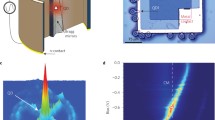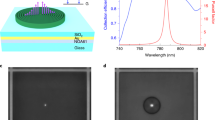Abstract
We propose two schemes that generate four-photon cluster states based on quantum dot microcavity coupling systems. In the first scheme, the four-photon cluster state is generated from four single-photon states assisted by three quantum dot nondemolition detectors. In the second scheme, a photon polarization controlled-Z (C-Z) gate is constructed firstly by exploiting a quantum dot microcavity coupling system, and then the four-photon cluster state is generated from two EPR pairs, which come from currently available spontaneous parametric down-conversion technique. Both nondemolition detectors and a photon polarization C-Z gate are realized by quantum dot microcavity coupling systems, which can be realized with near unity success probability and nearly perfect fidelity as the side leakage rate is small and the coupling strength is strong.






Similar content being viewed by others
Data availability
The authors confirm that the data supporting the findings of this study are available within the article.
References
Bennett, C.H., Brassard, G.: Quantum cryptography: public key distribution and coin tossing. Theoret. Comput. Sci. 560, 7–11 (2014). https://doi.org/10.1016/j.tcs.2014.05.025
Ma, X.F., Qi, B., Zhao, Y., Lo, H.K.: Practical decoy state for quantum key distribution. Phys. Rev. A 72, 012326 (2005). https://doi.org/10.1103/PhysRevA.72.012326
Basso Basset, F., Valeri, M., Roccia, E., Muredda, V., Poderini, D., Neuwirth, J., Spagnolo, R., Michele, B., Carvacho, G., Sciarrino, F., Trotta, R.: Quantum key distribution with entangled photons generated on demand by a quantum dot. Sci. Adv. 7, 6379 (2021). https://doi.org/10.1126/sciadv.abe6379
Li, W., Wang, L., Zhao, S.M.: Extended single-photon entanglement-based phase-matching quantum key distribution. Quant. Inf. Process. 21, 124 (2022). https://doi.org/10.1007/s11128-022-03464-2
Bennett, C.H., Brassard, G., Crépeau, C., Jozsa, R., Peres, A., Wootters, W.K.: Teleporting an unknown quantum state via dual classical and Einstein–Podolsky–Rosen channels. Phys. Rev. Lett. 70, 1895–1899 (1993). https://doi.org/10.1103/PhysRevLett.70.1895
Boschi, D., Branca, S., De Martini, F., Hardy, L., Popescu, S.: Experimental realization of teleporting an unknown pure quantum state via dual classical and Einstein–Podolsky–Rosen channels. Phys. Rev. Lett. 80, 1121–1125 (1998). https://doi.org/10.1103/PhysRevLett.80.1121
Kazemikhah, P., Aghababa, H.: Bidirectional quantum teleportation of an arbitrary number of qubits by using four qubit cluster state. Int. J. Theoret. Phys. 60, 378–386 (2021). https://doi.org/10.1007/s10773-020-3380-4704-w
He, W.T., Wang, J., Zhang, T.T., Alzahrani, F., Hobiny, A., Alsaedi, A., Hayat, T., Deng, F.G.: High-efficiency three-party quantum key agreement protocol with quantum dense coding and bell states. Int. J. Theor. Phys. 58, 2834–2846 (2019). https://doi.org/10.1007/s10773-019-04167-8
Zhang, J., Peng, K.C.: Quantum teleportation and dense coding by means of bright amplitude-squeezed light and direct measurement of a bell state. Phys. Rev. A 62, 064302 (2000). https://doi.org/10.1103/PhysRevA.62.064302
Long, G.L., Zhang, H.R.: Drastic increase of channel capacity in quantum secure direct communication using masking. Sci. Bull. 66, 1267–1269 (2021). https://doi.org/10.1016/j.scib.2021.04.016
Huang, Z.M., Rong, Z.B., Zou, X.F., He, Z.M.: Semi-quantum secure direct communication in the curved spacetime. Quant. Inf. Process. 20, 375 (2021). https://doi.org/10.1007/s11128-021-03316-5
Bai, C.M., Zhang, S.J., Liu, L.: Quantum secret sharing for a class of special hypergraph access structures. Quant. Inf. Process. 21, 119 (2022). https://doi.org/10.1007/s11128-022-03425-9
Raussendorf, R., Briegel, H.J.: A one-way quantum computer. Phys. Rev. Lett. 86, 5188–5191 (2001). https://doi.org/10.1103/PhysRevLett.86.5188
Chen, K., Li, C.-M., Zhang, Q., Chen, Y.A., Goebel, A., Chen, S., Mair, A., Pan, J.W.: Experimental realization of one-way quantum computing with two-photon four-qubit cluster states. Phys. Rev. Lett. 99, 120503 (2007). https://doi.org/10.1103/PhysRevLett.99.120503
Walther, P., Resch, K.J., Rudolph, T., Schenck, E., Weinfurter, H., Vedral, V., Aspelmeyer, M., Zeilinger, A.: Experimental one-way quantum computing. Nature 434, 169–176 (2005). https://doi.org/10.1038/nature03347
Briegel, H.J., Raussendorf, R.: Persistent entanglement in arrays of interacting particles. Phys. Rev. Lett. 86, 910–913 (2001). https://doi.org/10.1103/PhysRevLett.86.910
Walther, P., Aspelmeyer, M., Resch, K.J., Zeilinger, A.: Experimental violation of a cluster state bell inequality. Phys. Rev. Lett. 95, 020403 (2005). https://doi.org/10.1103/PhysRevLett.95.020403
Li, D.C., Cao, Z.L.: Teleportation of two-particle entangled state via cluster state. Commun. Theor. Phys. 47, 464–466 (2007). https://doi.org/10.1088/0253-6102/47/3/017
Shi, Y., Waks, E.: Deterministic generation of multidimensional photonic cluster states using time-delay feedback. Phys. Rev. A 104, 013703 (2021). https://doi.org/10.1103/PhysRevA.104.013703
Zou, X.B., Mathis, W.: Generating a four-photon polarization-entangled cluster state. Phys. Rev. A 71, 032308 (2005). https://doi.org/10.1103/PhysRevA.71.032308
Park, H.S., Cho, J., Lee, J.Y., Lee, D.H., Choi, S.K.: Two-photon four-qubit cluster state generation based on a polarization-entangled photon pair. Opt. Express 15, 17960 (2007). https://doi.org/10.1364/OE.15.017960
Zhu, M.Z., Yuan, G.Y.: Efficient scheme for preparing polarization-entangled photonic cluster states based on cross-Kerr nonlinearity. Int. J. Quant. Inf. 9, 1319–1327 (2011). https://doi.org/10.1142/S0219749911007915
Dong, L., Wang, J.X., Xiu, X.M., Dong, H.K., Li, D., Gao, Y.J.: A generation scheme of the distributed four-photon cluster-type polarization-entangled states exploiting the integration of entanglement gates and the controlled phase gate. Int. J. Quant. Inf. 11, 1350064 (2013). https://doi.org/10.1142/S0219749913500640
Xiu, X.M., Dong, L., Shen, H.Z., Gao, Ya.Jun., Yi, X.X.: Preparing, linking, and unlinking cluster-type polarization-entangled states by integrating modules. Progr. Theoret. Exp. Phys. 2013, 093A01 (2013). https://doi.org/10.1093/ptep/ptt069
Ji, Y.Q., Jin, Z., Zhu, A.D., Wang, H.F., Zhang, S.: Complete hyperentangled state analysis and generation of multi-particle entanglement based on charge detection. Chin. Phys. B 23, 050306 (2014). https://doi.org/10.1088/1674-1056/23/5/050306
Zhang, J.L., Su, S.L., Zhang, S., Zhu, A.D., Wang, H.F.: Complete and nondestructive polarization-entangled cluster state analysis assisted by a cavity input-output process. J. Opt. Soc. Am. B 33, 342 (2016). https://doi.org/10.1364/JOSAB.33.000342
Feng, L.T., Zhang, M., Zhou, Z.Y., Chen, Y., Li, M., Dai, D.X., Ren, H.L., Guo, G.P., Guo, G.C., Tame, M., Ren, X.F.: Generation of a frequency-degenerate four-photon entangled state using a silicon nanowire. NPJ Quant. Inf. 5, 90 (2019). https://doi.org/10.1038/s41534-019-0205-4
Tiurev, K., Appel, M.H., Mirambell, P.L., Lauritzen, M.B., Tiranov, A., Lodahl, P., Sørensen, A.: High-fidelity multiphoton-entangled cluster state with solid-state quantum emitters in photonic nanostructures. Phys. Rev. A 105, L030601 (2022). https://doi.org/10.1103/PhysRevA.105.L030601
Djordjevic, I. B.: Cluster state-based quantum computing. Quant. Inf. Process. Quant. Comput. Quant. Error Correct. 531–561 (2021). https://doi.org/10.1016/B978-0-12-821982-9.00004-6
Ju, L., Yang, M., Xue, P.: A proposal for preparation of cluster states with linear optics. Chin. Phys. B 30, 030306 (2021). https://doi.org/10.1088/1674-1056/abd74b
Hu, C.Y.: Spin-based single-photon transistor, dynamic random access memory, diodes, and routers in semiconductors. Phys. Rev. B 94, 245307 (2016). https://doi.org/10.1103/PhysRevB.94.245307
Wei, H.R., Deng, F.G.: Universal quantum gates for hybrid systems assisted by quantum dots inside double-sided optical microcavities. Phys. Rev. A 87, 022305 (2013). https://doi.org/10.1103/PhysRevA.87.022305
Loss, D., DiVincenzo, D.P.: Quantum computation with quantum dots. Phys. Rev. A 57, 120–126 (1998). https://doi.org/10.1103/PhysRevA.57.120
Moody, G., McDonald, C., Feldman, A., Harvey, T., Mirin, R.P., Silverman, K.L.: Electronic enhancement of the exciton coherence time in charged quantum dots. Phys. Rev. Lett. 116, 037402 (2016). https://doi.org/10.1103/PhysRevLett.116.037402
Dusanowski, Ł, Nawrath, C., Portalupi, S.L., Jetter, M., Huber, T., Klembt, S., Michler, P., Höfling, S.: Optical charge injection and coherent control of a quantum-dot spin-qubit emitting at telecom wavelengths. Nat. Commun. 13, 748 (2022). https://doi.org/10.1038/s41467-022-28328-2
Vajner, D.A., Rickert, L., Gao, T., Kaymazlar, K., Heindel, T.: Quantum communication using semiconductor quantum dots. Adv. Quant. Technol. 5, 2100116 (2022). https://doi.org/10.1002/qute.202100116
Li, J.X., Dwivedi, P., Kumar, K.S., Roy, T., Crawford, K.E., Thomas, J.: Growing perovskite quantum dots on carbon nanotubes for neuromorphic optoelectronic computing. Adv. Electron. Mater. 7, 2000535 (2021). https://doi.org/10.1002/aelm.202000535
Rudno-Rudziński, W., Burakowski, M., Reithmaier, J.P., Musiał, A., Benyoucef, M.: Magneto-optical characterization of trions in symmetric INP-based quantum dots for quantum communication applications. Materials 14, 1–15 (2021). https://doi.org/10.3390/ma14040942
Li, X.W., Cai, W.S., Guan, H.L., Zhao, S.Y., Cao, S.L., Chen, C., Liu, M., Zang, Z.G.: Highly stable cspbbr3 quantum dots by silica-coating and ligand modification for white light-emitting diodes and visible light communication. Chem. Eng. J. 419, 129551 (2021). https://doi.org/10.1016/j.cej.2021.129551
Arakawa, Y., Holmes, M.J.: Progress in quantum-dot single photon sources for quantum information technologies: a broad spectrum overview. Appl. Phys. Rev. 7, 021309 (2020). https://doi.org/10.1063/5.0010193
Xu, Y., Guo, Q., Si, B., Cheng, L.Y., Wang, H.F., Zhang, S.: Generation of multi-photon Greenberger-Horne-Zeilinger states and cluster states through a quantum-dot spin in optical microcavity. Opt. Commun. 313, 294–298 (2014). https://doi.org/10.1016/j.optcom.2013.09.067
Zhou, Y.S., Li, X., Deng, Y., Li, H.R., Luo, M.X.: Generation of hybrid four-qubit entangled decoherence-free states assisted by the cavity-QED system. Opt. Commun. 366, 397–403 (2016). https://doi.org/10.1016/j.optcom.2015.12.065
Bai, C.H., Wang, D.Y., Shi, H., Cui, W.X., Jiang, X.X., Wang, H.F.: Scheme for implementing multitarget qubit controlled-not gate of photons and controlled-phase gate of electron spins via quantum dot-microcavity coupled system. Quant. Inf. Process. 15, 1485–1498 (2016). https://doi.org/10.1007/s11128-015-1197-4
Dong, L., Lv, L., Yang, Z.L., Liu, S.T., Wang, X.Y., Geng, X., Ren, Y.P., Ji, Y.Q., Xiu, X.M.: Deterministic preparation of a hyper-entangled three-photon asymmetric w state assisted by the single-sided qd-cavity system. Adv. Quant. Technol., 2200092 (2022). https://doi.org/10.1002/qute.202200092
Wei, H.R., Deng, F.G.: Universal quantum gates on electron-spin qubits with quantum dots inside single-side optical microcavities. Opt. Express 22, 593 (2014). https://doi.org/10.1364/OE.22.000593
Zheng, Y.Y., Liang, L.X., Zhang, M.: Error-heralded generation and self-assisted complete analysis of two-photon hyperentangled bell states through single-sided quantum-dot-cavity systems. Sci. China Phys. Mech. Astron. 62, 970312 (2019). https://doi.org/10.1007/s11433-018-9338-8
Zhao, Z.L., Han, B.: Lie symmetry analysis of the Heisenberg equation. Commun. Nonlinear Sci. Numer. Simul. 45, 220–234 (2017). https://doi.org/10.1016/j.cnsns.2016.10.008
Bouwmeester, D., Pan, J.W., Mattle, K., Eibl, M., Weinfurter, H., Zeilinger, A.: Experimental quantum teleportation. Nature 390, 575–579 (1997). https://doi.org/10.1038/37539
Kwiat, P.G., Mattle, K., Weinfurter, H., Zeilinger, A., Sergienko, A.V., Shih, Y.: New high-intensity source of polarization-entangled photon pairs. Phys. Rev. Lett. 75, 4337–4341 (1995). https://doi.org/10.1103/PhysRevLett.75.4337
Żukowski, M., Zeilinger, A., Horne, M. A., Ekert, A. K.: Event-ready-detectors. Bell experiment via entanglement swapping. Phys. Rev. Lett. 71, 4287–4290 (1993). https://doi.org/10.1103/PhysRevLett.45271.4287
Bennett, C.H., Brassard, G., Crépeau, C., Jozsa, R., Peres, A., Wootters, W.K.: Teleporting an unknown quantum state via dual classical and Einstein-Podolsky-Rosen channels. Phys. Rev. Lett. 70, 1895–1899 (1993). https://doi.org/10.1103/PhysRevLett.70.1895
Mattle, K., Weinfurter, H., Kwiat, P.G., Zeilinger, A.: Dense coding in experimental quantum communication. Phys. Rev. Lett. 76, 4656–4659 (1996). https://doi.org/10.1103/PhysRevLett.76.4656
Pan, J.W., Bouwmeester, D., Weinfurter, H., Zeilinger, A.: Experimental entanglement swapping: entangling photons that never interacted. Phys. Rev. Lett. 80, 3891–3894 (1998). https://doi.org/10.1103/PhysRevLett.80.3891
Pan, J.W., Daniell, M., Gasparoni, S., Weihs, G., Zeilinger, A.: Experimental demonstration of four-photon entanglement and high-fidelity teleportation. Phys. Rev. Lett. 86, 4435–4438 (2001). https://doi.org/10.1103/PhysRevLett.86.4435
Kwiat, P.G., Mattle, K., Weinfurter, H., Zeilinger, A., Sergienko, A.V., Shih, Y.: New high-intensity source of polarization-entangled photon pairs. Phys. Rev. Lett. 75, 4337–4341 (1995). https://doi.org/10.1103/PhysRevLett.75.4337
Pan, J.W., Chen, Z.B., Lu, C.Y., Weinfurter, H., Zeilinger, A., Zukowski, M.: Multiphoton entanglement and interferometry. Rev. Mod. Phys. 84, 777–838 (2012). https://doi.org/10.1103/RevModPhys.84.777
Hu, X.M., Zhang, C., Liu, B.H., Guo, Y., Xing, W.B., Huang, C.X., Huang, Y.F., Li, C.F., Guo, G.C.: High-dimensional bell test without detection loophole. Phys. Rev. Lett. 129, 060402 (2022). https://doi.org/10.1103/PhysRevLett.129.060402
Tomm, N., Javadi, A., Antoniadis, N.O., Najer, D., Löbl, M.C., Korsch, A.R., Schott, R., Valentin, S.R., Wieck, A.D., Ludwig, A., Warburton, R.J.: A bright and fast source of coherent single photons. Nat. Nanotechnol. 16, 399–403 (2021). https://doi.org/10.1038/s41565-020-00831-x
Pan, J.W., Lu, C.Y.: Quantum-dot single-photon sources for the quantum internet. Nat. Nanotechnol. 16, 1294–1296 (2021). https://doi.org/10.1038/s41565-021-01033-9
Acknowledgements
This study was supported by National Natural Science Foundation of China (Grant Nos. 12247214, 11674037), LiaoNing Revitalization Talents Program (Grant No. XLYC1807206), LiaoNing BaiQianWan Talents program (Grant No. 2021921096), Natural Science Foundation of LiaoNing Province (Grant Nos. 2021-MS-317, 2022-MS-372), Startup Foundation for Doctors of Liaoning Province (Grant No. 2020-BS-234) and Foundation of Liaoning Province Education Administration (Grant Nos. LJKZZ20220120, LJ2020005, LJKZ1015).
Author information
Authors and Affiliations
Corresponding authors
Ethics declarations
Conflict of interest
The authors declare that they have no known competing financial interests or personal relationships.
Additional information
Publisher's Note
Springer Nature remains neutral with regard to jurisdictional claims in published maps and institutional affiliations.
Rights and permissions
Springer Nature or its licensor (e.g. a society or other partner) holds exclusive rights to this article under a publishing agreement with the author(s) or other rightsholder(s); author self-archiving of the accepted manuscript version of this article is solely governed by the terms of such publishing agreement and applicable law.
About this article
Cite this article
Yang, ZL., Xiu, XM., Lv, L. et al. Two schemes for generating four-photon cluster states based on quantum dot microcavity coupling systems. Quantum Inf Process 22, 121 (2023). https://doi.org/10.1007/s11128-023-03854-0
Received:
Accepted:
Published:
DOI: https://doi.org/10.1007/s11128-023-03854-0




